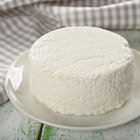
With fresh milk products, it's pretty easy to know when they're past their prime. They quickly develop a sharply sour taste and smell, and begin to curdle. Detecting spoilage is more challenging with cultured milk products such as yogurt or sour cream, because they start out curdled and tart. Sour cream is safe for extended periods, but only if it's handled correctly.
About Sour Cream
In the days before high-powered centrifuges were available to separate milk from cream, farmers warmed their milk and left it to sit in broad, shallow pans. The cream would rise to the top, where it could be separated. This typically produced cream with a fat content of 18 to 25 percent, which would sour naturally thanks to the natural bacteria in the dairy. Modern industrial sour cream averages 20 percent fat, and cultures pasteurized cream deliberately with pure, carefully controlled strains of beneficial bacteria. This provides a consistent, predictable product that's food safe and stable under refrigeration.
Dating
The freshness date on your sour cream's packaging is a sell-by date, rather than an expiration date. It's intended to ensure that your sour cream is sold while it's still at its freshest and best, and the freshness date is deliberately conservative. The U.S. Department of Agriculture's consumer refrigeration charts suggest up to three weeks' storage for sour cream in your refrigerator. As long as you've purchased your sour cream by its freshness date and kept it refrigerated, that's safe.
Open Packages
Once your sour cream has been opened, it's usually safe to continue using it for 7 to 10 days. At some point the liquid whey begins to separate, but that's natural and it isn't a sign of spoilage. You can either stir it in or pour it off, which thickens the cream slightly. Pouring it off is the better alternative, because by stirring it in you run the risk of introducing bacteria or mold spores from the air. If your sour cream develops moldy spots, a pungent cheesy odor or a visible pink or yellow-orange tinge, it's contaminated and should be discarded immediately.
Assumptions and Guidelines
Your sour cream might remain safe for longer periods, but it's prudent to be conservative where food safety is concerned. Keep your sour cream -- and other dairy products -- cold at all times. Pick them from the case at the end of your shopping trip, rather than the beginning. Keep them in a cooler on the way home, if possible, and refrigerate them immediately. Store sour cream near the rear of your fridge, where the temperature is most stable. Check your refrigerator's temperature regularly, to ensure it normally stays below a food safe temperature of 40 degrees Fahrenheit. If it doesn't, all of your perishable foods are in jeopardy until you have it serviced.
Related Articles
Clotted Cream Vs. Double Cream

What Is "Cultured Cream"?

Does a Chilled Champagne Bottle Need to ...
Does Sour Cream Go Bad if Unopened?

How Long Can a Bagel With Cream Cheese ...

Can You Eat Sour Cream If It's Been ...

What Happens if You Whip Condensed Milk?
What Do Bakeries Use in Their Whipped ...

Does Cream Curdle When It Goes Bad?

How Long Does Whipping Cream Stay Fresh ...

Do You Need to Refrigerate Homemade ...

Can I Freeze Milkshakes?

Facts About Cottage Cheese

Why Can't You Use Ultra Pasteurized ...

How Long Can I Keep Food Safe in a ...

Difference Between Fermented Milk & ...

Why Is My Pastry Cream Hardened?

Does Cream Spoil?

Can Drinking Old Vodka Hurt You?

How Long Can Quiche Be Left ...
References
- On Food and Cooking: The Science and Lore of the Kitchen; Harold McGee
- USDA Food Safety and Inspection Service: Food Product Dating
- Team Nutrition: Storage Tips
- USDA Food Safety and Inspection Service: Molds On Food -- Are They Dangerous?
Writer Bio
Fred Decker is a trained chef and prolific freelance writer. In previous careers, he sold insurance and mutual funds, and was a longtime retailer. He was educated at Memorial University of Newfoundland and the Northern Alberta Institute of Technology. His articles have appeared on numerous home and garden sites including GoneOutdoors, TheNest and eHow.
Photo Credits
Jupiterimages/Comstock/Getty Images